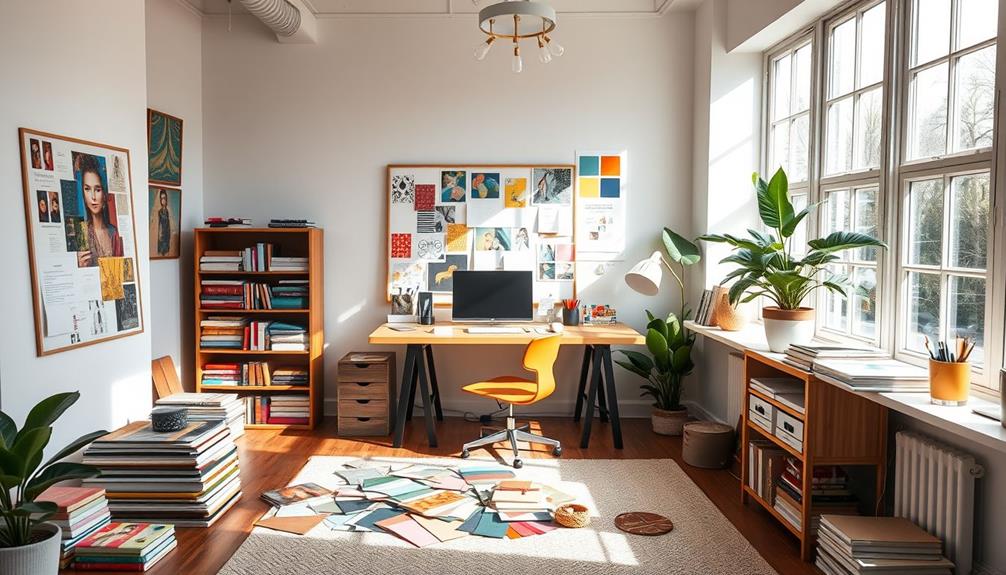To become an interior designer, start with self-assessment to clarify your passion and skills. You'll need a Bachelor's degree in interior design from an accredited program. Gain practical experience through internships, and pass the NCIDQ exam for certification in many states. Networking is essential, so join design associations and attend events. Also, hone your project management and communication skills, as they'll play a significant role in client interactions and vendor negotiations. With a commitment to ongoing education and a diverse portfolio, you can thrive in this field. There's plenty more to explore on your journey to becoming an interior designer. Consider specializing in a specific niche, such as residential or commercial design, to stand out in the industry. Additionally, familiarize yourself with the business side of interior design, including calculating interior design fees and creating contracts. Finding a mentor in the field can also provide valuable guidance as you navigate the complexities of the job. Overall, dedication, creativity, and a strong work ethic are key to success in the competitive world of interior design.
Key Takeaways
- Obtain a Bachelor's degree in interior design from an accredited program to build foundational knowledge and skills.
- Gain practical experience through internships, volunteering, and design competitions to enhance your portfolio.
- Pass the NCIDQ exam to achieve certification and licensing required in many states.
- Network with professionals through design associations and events for job opportunities and mentorship.
- Continuously engage in professional development and education to stay updated on industry trends and advancements.
Self-Assessment and Career Planning
Your journey to becoming an interior designer begins with a thoughtful self-assessment and career planning. Reflecting on your motivations for pursuing an interior design career is essential; it clarifies your passion and commitment to the profession.
Start by evaluating your existing design skills. Are you leaning more towards interior decorating or the more technical aspects of design? This assessment will guide your educational and career choices.
Understanding the difference between interior decorators and accredited interior designers is vital. This distinction influences the type of education you'll need and the certification required to succeed.
Next, assess your preferred design areas—whether residential, commercial, or healthcare—this will tailor your career path and help focus your education.
Education and Certification Requirements

Becoming an interior designer requires a solid educational foundation and the right certifications. To start, you'll typically need a Bachelor's degree in interior design or a related field, which usually involves four years of study. It's essential to choose accredited programs that cover important coursework, including design principles, color theory, and CAD, as these subjects provide the necessary groundwork for your career.
After earning your degree, you'll need to gain professional experience through supervised internships, which often serve as prerequisites for certification and an interior design license. To practice in many states, you must pass the National Council for Interior Design Qualification (NCIDQ) exam, which requires both your degree and specific work experience.
Once certified, continuing education is important to maintain your certification and stay current with industry trends. Ongoing learning is often necessary to renew your licenses and credentials.
Choosing the Right Design School

Selecting the right design school is essential for shaping your future as an interior designer. Start by researching various interior design programs that align with your career goals. Look for accredited programs recognized by the Council for Interior Design Accreditation (CIDA), such as those at the University of Cincinnati or Cornell University, known for their strong job placement rates.
When evaluating schools, conduct site visits to assess the atmosphere, facilities, and resources available. Engaging with current students and faculty can provide valuable insights into the program.
Confirm the design curriculum covers essential topics like interior design principles, color theory, and CAD software, while also offering hands-on experience through projects and portfolio development.
Don't overlook the importance of networking opportunities and internships. A program that emphasizes practical learning and connections within the design community can vastly enhance your interior design education.
Ultimately, choosing a school that balances academic rigor with real-world applications will prepare you for a successful career in interior design, equipping you with the skills and experiences you need to thrive in the industry.
Gaining Experience and Networking

Gaining hands-on experience is essential for aspiring interior designers, as it not only helps you log important work hours but also sharpens your practical skills in real-world settings.
Here are three effective ways to gain experience and expand your network:
- Internships: Seek internships with established firms to learn directly from industry professionals. This experience will enrich your portfolio and expose you to the day-to-day operations of interior design.
- Design Competitions: Engage in design competitions to showcase your talent. Not only do they offer visibility, but they also help you refine your skills and connect with potential employers.
- Volunteer Projects: Participate in volunteer or pro bono work within your community. This not only builds your portfolio but also enables you to give back while gaining valuable experience.
Additionally, networking through events, workshops, and design associations like IIDA and ASID is critical.
Building relationships with peers and established designers fosters collaboration and knowledge sharing, both fundamental for your professional development.
Professional Development Strategies

Building on your experience and connections, focusing on professional development is essential to advancing in the interior design field. Start by joining professional organizations like IIDA or ASID, which can enhance your leadership skills and provide valuable networking opportunities.
Engaging in continuing education through workshops and seminars is vital for staying updated on design trends and technology, including sustainability practices. Additionally, understanding the importance of quality assurance in your projects can greatly enhance client satisfaction, as ensuring software meets high-quality standards is critical in any design process.
Consider seeking mentorship from experienced designers who can offer insights into best practices and help refine your portfolio quality. Participating in community design projects not only builds your experience but also raises your visibility and fosters professional connections within the industry.
Maintaining a diverse portfolio is essential; actively seek feedback from peers to enhance your design capabilities and prepare for various client interactions and project challenges.
Ultimately, investing time in professional development will position you for long-term success and growth in your interior design career. By prioritizing these strategies, you'll be well-equipped to navigate the evolving landscape of the industry and emerge as a competent and sought-after designer.
Daily Life of an Interior Designer

As an interior designer, your day is a mix of creative tasks and essential project management.
You'll spend time creating layouts and calculating costs, while also juggling client meetings and site visits.
Balancing these responsibilities is key to ensuring your projects stay on track and meet client expectations.
Typical Daily Tasks
A typical day in the life of an interior designer involves a diverse mix of creative and administrative tasks.
You'll spend about 20% of your time sketching layouts and selecting materials, while the remaining 80% is focused on fundamental administrative duties.
Here's a glimpse into your daily responsibilities:
- Client Meetings: You'll regularly meet with potential clients to discuss their needs and expectations. Communication is key to guaranteeing satisfaction throughout the design process.
- Site Visits: These visits are essential for evaluating spaces and monitoring project progress. You'll coordinate with contractors to guarantee everything aligns with your design plans.
- Project Management: You'll calculate project costs, create timelines, and negotiate with vendors. This aspect of teamwork is critical in executing your design vision effectively.
Your typical working hours might be from 9 to 5, but you may need to extend those hours to meet deadlines or accommodate client schedules.
Whether you're collaborating with assistant designers or overseeing contractors, each task you tackle contributes to a successful project and a satisfied client.
Project Management Balance
In the fast-paced world of interior design, balancing project management with creative tasks is vital for success. As an interior designer, you'll find that about 80% of your time is spent on administrative tasks, including client meetings, budgeting, and vendor negotiations. This leaves only 20% for actual design work, making project management skills important.
You'll create detailed timelines and budgets to guarantee your designs stay on track and within financial constraints. Strong communication skills will help you understand your clients' needs and expectations, allowing you to deliver quality design that meets their vision. Daily interactions with clients can be demanding, but effective communication makes a significant difference.
Additionally, you'll conduct regular site visits to assess progress and address any issues, balancing on-site supervision with remote design work.
Multitasking is a must, as you'll manage multiple projects simultaneously while paying attention to detail.
Conclusion
Becoming an interior designer can seem intimidating, but remember, every expert was once a beginner. Embrace the journey of learning and growing in this vibrant field. As you navigate your education, gain experience, and build your network, you'll discover your unique style and voice. Don't worry about perfection right away—creativity takes time. So plunge in, stay curious, and enjoy the process. You've got what it takes to transform spaces and inspire others!









